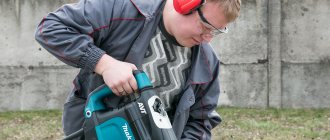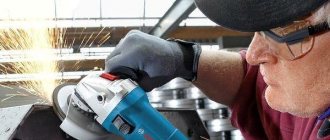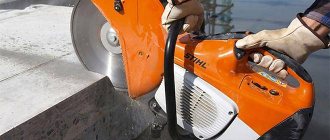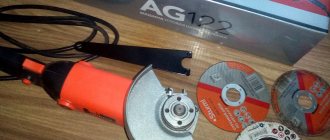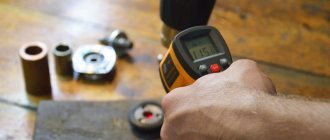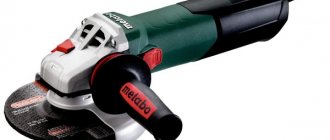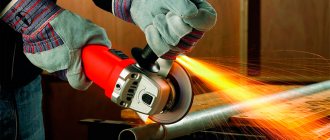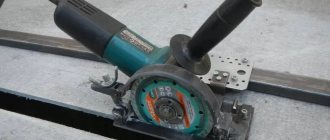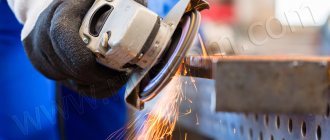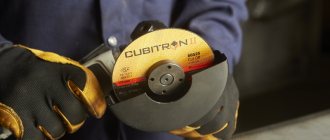Interacting with any tool, both electrified and mechanical, always poses a health hazard. One of the most popular devices at work and at home is the angle grinder.
The scope of its application is very wide. Scale, dust and small particles fly out from under its disk. Therefore, to protect the eyes, safety glasses are used when working with an angle grinder.
Safety precautions
There are several types of protective equipment required when operating this device.
Individual protection means
A guarantee of eye safety when using an angle grinder is safety glasses . They have several varieties:
- Open type glasses. They resemble ordinary glasses for vision correction or sun protection, but have a denser structure and increased plastic thickness. These glasses protect your eyes from sparks and small fragments. Their disadvantage is their lack of protection from dust. When working with ceramics and stone, dust is generated that can cause eye irritation. In this case, the following type of glasses is suitable.
- Closed-type glasses. They fit tightly to the contour of the face and prevent dust from entering the eyes. They also protect your eyes from splinters and sparks. Some models have a ventilation system that prevents fogging of the inner surface of the lenses. This version of glasses will cost a little more, but it also has more advantages.
Glasses must be worn regardless of the nature of the material being cut or sanded.
Protective mask
Another safety device when working with an angle grinder is a protective mask .
It can be reinforced with a special mesh, which makes it stronger. This mask is much better than glasses, because it protects not only the eyes, but also the rest of the face. The main cause of injury is a split saw blade. Its fragments, flying at great speed, can injure not only the person working with the angle grinder, but also those nearby.
Principles of safe work
The presence of personal protective equipment undoubtedly reduces the risk of injury when using an angle grinder. But it is also worth remembering other safety requirements .
- Protective cover. This device must be on the angle grinder. Some careless operators remove the protection in order to put on a wheel of a larger diameter, which is not intended to work with this angle grinder. Sometimes the casing is removed in cases where it is necessary to use the grinder at an awkward angle. Such actions are unacceptable. Of course, the protective casing does not provide 100% safety, but in most cases it will protect you from injury. Recently, the protective cover for angle grinders has received a useful modification. It's called a dust extractor. From the name it is clear - this device helps direct dust particles in the opposite direction from the operator, which greatly simplifies the work.
- Hand protection. To prevent sparks and hot metal particles from coming into contact with the skin of your hands, it is recommended to use special welding gloves. Small sparks hitting the skin do not cause obvious pain. But when a large burning particle hits, it causes severe pain. At this moment, the hand may shake, thereby creating a traumatic situation. Gaiters will help prevent hot metal from getting on your hands.
- Selecting an abrasive wheel. To work with an angle grinder, you should only use a wheel that is suitable for it. If you use a circle with a diameter larger than expected, it may break without even touching
- with the cutting object. The fact is that different models of angle grinders have different speeds, and abrasive wheels have different speed resistance.
- You should also not use wheels with visible external defects, such as chips, deep scratches or cracks.
- It is forbidden to install a disk on the grinder for sawing wooden products. Firstly, it is dangerous - the saw blade may encounter a knot, which can cause the tool to be torn out of your hands. Secondly, the disk will very soon become unusable, because it is not adapted to such a load. The speed of a circular saw is much lower than that of an angle grinder.
- Sawing object. If the element being processed is small in size, you need to secure it with something. The best option for this would be to use a vice. It is strictly forbidden to saw the product with one hand while holding it with the other. In this case, the sawing element may be torn out of your hands.
If the product is large and installed motionless , it is necessary to ensure that the abrasive disc does not bite. General rules:
- Always unplug the angle grinder when replacing a blade. This is to prevent accidental startup.
- When choosing an abrasive disc, give preference to a trusted manufacturer.
- When working, make sure that the power cord is kept away from the sawing wheel.
- When using an angle grinder, avoid the possibility of hair and clothing getting wrapped around the rotating disc.
How to work with an angle grinder?
So, you bought a suitable grinder and wheels for it. I have no experience working with an angle grinder, the tool is dangerous and it’s scary to approach it. But we need to work. What to do? First of all, you need to take care of protective equipment. At a minimum, you should protect your face and hands. The shield mask is convenient because it protects the lower part of the face, but it fogs up when you take a deep breath. The glasses do not have this drawback, but the nose and mouth remain open to sparks. Therefore, it is advisable to use a respirator along with glasses.
Means of protection
You should pay attention to the quality of fastening the mask to the straps. Typically this fastening consists of screws with plastic wings that must be tightened as tightly as possible. It is very inconvenient when the mask dangles and falls off when bending forward.
The face shield can be made of plexiglass or polycarbonate. The second option is preferable, because polycarbonate is much stronger than plexiglass. A fragment of a flying disk will immediately pierce the plexiglass, and the polycarbonate, although it will be pierced, will retain the fragment of the disk. It is difficult to say whether a damaged mask will withstand being hit by shrapnel again. It’s better not to tempt fate and purchase a new means of protection.
It should be borne in mind that complete protection cannot be achieved either from a face shield or from glasses. Sparks fly along a completely incomprehensible trajectory and fly under the mask. And sometimes, oddly enough, even under glasses. Another feature of cheap plastic masks and glasses is their vulnerability to sparks: as soon as you catch a sheaf of sparks, the plastic becomes dull.
It makes sense to purchase a clear mask with head protection or even a welding helmet. There are closed masks with a breathing filter. They are a labyrinth of bulkheads (a fragment, once there, spends all its inertia on ricochets between the walls).
A gas mask best protects your head. Old-style military gas masks protect the eyes with glass eyepieces that are resistant to sparks. However, the viewing angle is too small for comfortable work. Modern gas masks with a panoramic mask are much more convenient. Unfortunately, such protection is not cheap.
Gloves as a means of protection when working with an angle grinder
Gloves should be of the appropriate size so that there is no empty space at the fingertips. If your hand is close to the disk and the dangling tip gets caught in the rotating disk, you risk missing the moment when it is not too late to remove your hand. Moreover, the smaller the “grinder”, the more pressing this problem. If the glove fits perfectly on your hand, the maximum you are in danger of is cutting yourself on the edge of the rotating disk.
A glove will not save you from a cut, but it will minimize the damage. Gloves are also useful because cutting sheet metal results in razor-sharp cutting edges. In other words, carelessly touching the cut without gloves can result in a deep cut. The metal heats up from friction, and you can get burned on the freshly cut workpiece if you do not use gloves. Clothes should not restrict movement, but nothing should hang down. The grinder will tighten laces, ties, the ends of the belt or wide sleeves so quickly that you won’t have time to understand anything. The problem is that by tightening the clothes, the tool gets closer to the body, and it is not at all a fact that by this moment you will have time to turn off the motor.
Long hair must be tied into a bun or ponytail. Ordinary clothing can catch fire when exposed to sparks. Therefore, it is recommended to wear a thick apron for metalwork or overalls impregnated with a fire-resistant compound over clothing.
In general, when working with a dangerous tool, protection is never enough. The above-described set of protective equipment can be supplemented with shoes with a metal toe cap. It protects the feet from disc fragments. You can build real iron chain mail using the experience of historical battle reenactors. Chain mail protects well from large fragments, but it will allow sparks to pass through. The same goes for metal mesh masks.
For those who spend a lot of time with a grinder in their hands every day, soundproofing headphones or earplugs will be useful. After many hours of work, the ringing in the ears will persist for several days. And doing such work constantly, without resorting to ear protection, can easily damage your hearing.
Working with an angle grinder
The “grinder” itself is provided with minimal protection. Actually, it has only one means of protection: a casing installed on the gearbox and covering half of the disk. This casing must be rotated in such a way as to protect the technician from sparks and fragments of the disk when it ruptures. An additional handle is placed above this casing to avoid hand contact with the cutting edge. It is technically possible to install the handle on the opposite side of the casing, but then the hand will be dangerously close to the working area, which is fraught with serious injuries.
Correct installation of the equipment is of great importance. Different craftsmen place abrasive discs in different ways: some with the label facing the gearbox, others with the label facing out. Beginners often have a question: which installation option is correct? Meanwhile, due to the absence of teeth, the direction of movement of the edge does not matter. There is, however, one caveat. The mounting hole of the abrasive discs is framed by a metal ring, which, according to the manufacturer’s plan, should take on part of the load when the flange self-clamps. Usually the disk is placed so that this ring is under the flange.
How to avoid self-tightening of the flange?
Self-tightening of the flange is possible when the disk jams, when the disk and the flange ground to it stop, and the spindle continues to rotate. Self-clamping also occurs during a sharp start, when the flange and disk remain in place by inertia, and the spindle makes a jerk. Sometimes the flange is tightened so that attempts to release the fastener lead to breakage of the open-end wrench, the locking button (it is plastic and therefore very fragile) and even the gearbox housing.
You can avoid self-clamping by placing a washer under the flange. You can find a metal washer of suitable size, or you can cut it out of plastic, cardboard or even paper. A rubber washer would be a very good solution. With a tightening jerk, it stretches, and after the tension subsides, it returns to its previous position.
Naturally, when using branded mechanical superflanges (BOSH, Makita), the problem of self-clamping ceases to be relevant. True, new problems are emerging. For example, if you forget to press the folding bracket, you risk catching it on the workpiece or workbench, which will lead to irreparable damage to the quick-clamping mechanism.
It might make sense to buy a primitive nut with a moving washer that can be tightened with a regular wrench. Having a minimum of structural elements, such a nut is highly reliable and quite cheap, and most importantly, it solves the problem of self-clamping no worse than overseas miracle mechanisms.
When working with a small angle grinder that is not equipped with an automatic soft start, you can tighten the flange by hand rather than with a key, because during the starting jerk it will tighten itself quite well. When starting smoothly, it is necessary to screw the flange with a wrench. On large angle grinders, the nut should be tightened tightly with a wrench, even if the machine is not equipped with a soft start.
The choice of equipment deserves special attention. Cutting wheels used for cutting metal are very popular today. They consist of an abrasive reinforced with fiberglass mesh.
Cutting materials with a grinder
In principle, it is possible to sharpen the workpiece with the surface of the disk, but it is not worth it: the mesh is located too close to the surface, and if it is damaged, the disk will lose strength. You need to sharpen either with the edge of a cutting disc or with special cleaning discs. In addition, use a sharpening stone on a sharpening machine, putting the grinder aside (in general, think as often as possible whether the planned work should really be done with a grinder).
For cutting stone, brick, concrete and tiles, there are special diamond-coated cutting discs with cooling slots along the edge. It is recommended to cut these materials at low speeds.
What can you cut with a grinder?
Many people look with hope at the “grinder” when the need arises to cut wood, plywood, chipboard or plastic. The angle grinder is too fast to do this kind of work. Therefore, cutting wheels melt and splatter plastic, burn plywood and wood. And here many craftsmen are tempted to install a circular saw blade. The devil is in the details. The sizes of saw blades are slightly larger than those for angle grinders. But this “slightly” is quite enough to prevent the installation of the protective casing.
It would seem that this is the first sign that the idea needs to be abandoned, but the master who has succumbed to temptation usually does not stop and removes the casing to install the saw blade. And it is much heavier than abrasive! Given its weight, it is not designed for speeds of 11,000 (or even 7,000) rpm. The result of going beyond the limits of documented capabilities is vibration, which is felt even on weak angle grinders. A strong machine (for a 230 mm blade) with a saw blade is almost impossible to hold in your hands due to the frantic vibration, and the gyroscopic effect does not allow you to change the position of the tool in space. Craftsmen who have once worked with a large grinder with a saw blade talk about the thrill that cannot be forgotten.
When the saw blade jams
When a saw blade jams, the kickback will not only be strong, but also incredibly fast. You may simply not have time to react. When using a lightweight and relatively weak abrasive disc, the force of the reverse thrust is limited by its strength. A car with a steel disk accelerated to the limit will be torn out of your hands with a quick and powerful blow. Moreover, the trajectory along which it will fly is difficult to predict. Ruptures of steel discs also occur; As the masters gloomily joke, anyone who has seen such a disk rupture will never talk about it again.
Recently, saw blades with a bore hole diameter and outer diameter suitable for angle grinders have begun to appear on the market. Imagine: you are holding in your hands a steel disk with pobedit tips (or with a chain from a chainsaw). It's heavy—probably steel. There are circular stripes on the surface - the disc is probably calibrated, packed in a good cardboard envelope, inside a plastic bag, even a soft plastic sponge is put on the teeth. Its parameters and purpose are described on the packaging in the purest Russian language, the company logo and even the website address are printed. And when you go to the website, it turns out that the company does not produce anything, but only exports consumables from China.
In what basement, on what equipment and from what materials the disc was made, one can only guess. And the soldering seems to be similar to Pobedit, and seems to hold up perfectly. But no one guarantees the reliability of welding, and it is unknown how quickly they will start flying off.
Carefully! Do not place the saw blade in the grinder
You need to firmly remember: the “grinder” is not designed for the use of a toothed disc. The steel disc is too heavy for such speed, and the angle grinder is too sensitive to tilts and distortions. Yes, at first the nameless discs do not fly into pieces, they cut instantly and give a perfectly even cut. But if the solder suddenly falls off or the steel breaks, turning out to be only an alloy similar to steel, there will be no one to hold accountable: the manufacturer is unknown.
Manufacturers of wood saw blades for grinders
Not a single famous brand produces saw blades for angle grinders. Unlike the nameless Chinese cellars, seeking only to cover demand and make money. Well-known manufacturers value their reputation. Having shown such blatant incompetence, the company would have to pay not only with money, but also with the permanent loss of its name. That is why the honorable gentlemen do not produce consumables that violate safety requirements. You cannot use saw blades on angle grinders - that's it.
However, well-known manufacturers are making legal attempts to make angle grinders more universal. For example, BOSH produces a universal cutting disc Multi Wheell 2 608 623 013. This is a carbide abrasive (not a saw, mind you) disc with cooling slots. Thanks to them, the heating of the material is noticeably reduced. There are no protruding elements in the slots. Compared to the “toothy” nonames from China, such a disc gives a slightly shaggy cut. However, no more dangerous than a regular abrasive disc. It cuts metal, plastic, wood, plywood and chipboard perfectly. He doesn’t even trip over nails—he grinds them together like a regular cutting wheel.
Grinding discs for grinders
Sanding cups usually extend beyond the casing, while others require its removal altogether. In this case, the decisive role is played by body protection - a mask, a respirator, a robe and gloves. If the abrasive discs break into pieces, then the wire grinding cups throw thin wires in all directions that dig deep into the body (they are especially dangerous when they get into unprotected respiratory tracts, the oral cavity, the sclera and the cornea of the eye).
Alone, they are almost invisible, so they cannot always be removed at home. Meanwhile, the irritation they cause is serious enough to land the victim in a hospital bed. It follows that when using sanding cups, protecting the machine becomes meaningless. But body protection, which is necessary in any case, becomes critically important.
So, the safety rules have been followed, the grinder has been assembled, and the equipment has been installed. It's time to get ready for work. First of all, you should fix the workpiece well. When cutting pipes, some craftsmen simply press them with their feet. And when cutting brick, it is simply placed on a flat, stable surface. It is extremely undesirable to do this: it is much more convenient to process a well-fixed workpiece. First of all, your hands are freed up for a more secure grip on the tool, your legs are freed up for a more secure stance, and your body gets more freedom, which makes work more comfortable and safer. Do not place the workpiece on two supports and cut in the middle. As the workpiece deepens, it will begin to sag towards the cut and jam the disk. It is more correct to fix one side of the workpiece, leaving the other side hanging. In this case, the cut end falls out and the cut only expands, which not only helps to avoid getting stuck, but also makes the work easier.
What is the most comfortable way to hold the earpiece?
There is no consensus on how it is more convenient to hold an angle grinder. Despite the simplicity of the angle grinder design, a variety of grip options are allowed. Each master chooses the appropriate grip himself. The main thing is to remember that the casing must be between the master and the disk, as well as between the disk and the additional handle. No parts of the body should be in the plane of rotation of the disk, or more precisely, in the sector of scattering of sparks and fragments of the disk (this rule is not difficult to observe if a protective casing is installed).
Angle grinder bodies come in two types: one-handed (you can hold the body with one hand, the power button is located directly on the body) and two-handed (they have a “tail” with a button in the back, it is convenient to hold the “tail” with one hand while holding the additional handle with the other) . Usually small and weak “grinders” are made one-handed. While the big and strong ones are made two-handed. With a two-handed grip, one hand acts as the primary hand and the other as the secondary hand.
There is no consensus on which hand should play which role. Some craftsmen believe that the main hand is the one that holds the body (for one-handed machines), and the secondary hand is the one that holds the additional handle. Others see the main hand holding an additional handle (in their opinion, it guides the tool), while the other hand only supports the body (or the “tail” if the grinder is two-handed). To understand which position is more comfortable, you need to try working in different positions.
Three slots for an additional handle
Most modern angle grinders have three sockets for an additional handle: two on the sides (perpendicular to the spindle) and one on the back of the gearbox (parallel to the spindle). It was said above that you cannot place the handle near the open part of the disk. Thus, there are two seats left: at the casing and at the “back of the head”. It should be remembered that the hand in a state of pronation (palm down) is very unstable, and the most stable position of the hand is semi-pronation (palm to the side). When preparing an angle grinder for cutting, the handle must be installed perpendicular to the spindle. When the disk is in a vertical position, characteristic of cutting, the handle will stand vertically and the master’s hand will take the most stable position - semi-pronation.
Everything that has been said is also true for grinding: when the disk is positioned horizontally, it is better to place the handle on the back side of the gearbox so that it stands vertically. Since grinding is carried out by the surface of the grinding wheel and the disc is not immersed in the material, this process is not as sensitive to tool misalignment as cutting. For this reason, the horizontal position of the handle is quite acceptable. Some cheap angle grinders don't even have a rear handle socket. If desired, a bracket can be designed for such a machine, screwed to the side holes and equipped with a handle mount. The bracket must be strong enough; for manufacturing it is advisable to use thick, durable metal. Such staples are produced industrially; They are much more convenient than homemade ones, although they are quite expensive.
Where should the sparks be directed when working with an angle grinder?
There is a lot of debate about where the sparks should be directed: from oneself or towards oneself. It is considered the most correct position for the angle grinder when sparks fly towards the machine body. Considering the standard direction of rotation of the disk for all grinders, this direction of the sparks assumes that the spindle is directed to the left if you hold the tool from the side. Or forward, if you hold the tool with the spindle away from you. However, the gearbox has at least two sockets for the handle. But, as already mentioned, you cannot place it at the open edge of the disk.
This means that tool manufacturers allow the installation of a handle and casing for working with sparks from themselves. In fact, there is nothing terrible in this direction of sparks. You just need to understand where the disk fragments and the car itself will fly in the event of a reverse impact. This directly depends on the direction of the force vector. And this vector goes from the point of contact in the direction opposite to the direction of rotation of the disk.
You can touch the workpiece in such a way that the return blow will throw the machine right into the master’s face. Or you can do it differently - so that the car jumps up or goes sideways. It is not difficult to predict the direction of the reverse jerk if you imagine the disk as a wheel that can push off from the material and move. Regardless of the direction of the sparks, you need to hold the car in such a way that when it jams and is torn out of your hands, it will either drive away from you or drive past you. A successful choice of the point of contact of the disk with the material will make it safe to work with sparks from yourself.
How not to overheat?
To avoid overheating of the blade, after 60 seconds of continuous operation, remove it from the cut for 30 seconds without turning off the machine. Overheating of the disc leads to a decrease in its strength and cauterization of the cut edges. Do not tilt the machine while the rotating blade is in the cut. This creates a danger of jamming, and the cut will be uneven. When cutting metal, you can only look into the working area from the side of the spindle (where the disk is not covered by a casing) wearing safety glasses.
Abrasive discs are ground not only in diameter, but also in thickness. When replacing a worn disk with the same new one, you need to keep in mind that its thickness is several microns greater. When entering a cut that has already begun, the disc will most likely get stuck. Therefore, after replacing the equipment, you need to enter the started cut from the opposite side of the “fork”.
To prevent the discs from wearing out too quickly, when cutting metal, the machine should be driven with the gearbox forward so that the disc hits the material from top to bottom. When moving the gearbox backwards, the disk goes from bottom to top, and can noticeably grind off towards the end of the cut if the cut is long enough.
It should be remembered that during coasting (the so-called inertial rotation after turning off) the disk is no less dangerous than when the engine is turned on. Touching the body with a disc that has not yet stopped can result in serious injury. You cannot put down, and especially throw the angle grinder with the disc down during the run-out. After turning off the motor, you must wait until the spindle has completely stopped. You can slow down the disc on the material. In order not to spoil the workpiece, you can attach a small piece of material near the workplace specifically for this purpose.
Cutting with a grinder grinder
Being a grinder, the grinder cuts by grinding at high speed. There is no need to press on the tool - cutting should occur without force; pressing will lead to jamming of the equipment. When the disk is immersed in the material, the friction area increases, so when the disk jams, the whole body of the machine jerks. Perhaps it will fly head over heels, everything will happen very quickly. The disk should be immersed shallowly, only a couple of millimeters, which is not difficult when cutting thin-sheet material.
The friction area will be quite small, and the point of contact will be located at the edge of the disk. And if the equipment jams, the tool will simply drive away like a one-wheeled vehicle. When cutting thick products, you do not need to immerse the blade deeper than required. In general, it is better not to cut thick workpieces with a grinder, but to take a tool more suitable for this.
It is impossible not to mention here that the widespread opinion about the universality of angle grinders arose due to the low cost of this tool. In fact, craftsmen who try to do most of the work with a grinder are wishful thinking in order to save money. An angle grinder is a grinding machine, and the ability to cut with it is secondary, if not incidental.
You should try to use the grinder for cutting as little as possible. It is convenient and safe to cut long thick boards with a circular saw, cutting down trees is more convenient with a gasoline chain saw, and it is convenient to make curved cuts of plywood and chipboard with a jigsaw. And for small cuts, recesses, cuts with sharp corners and light grinding, a multifunctional and safe oscillation cutter is suitable.
In conclusion, a few general comments
An angle grinder is a high-speed tool, and this is where its danger lies. Jamming of the disk when cutting is especially dangerous, which should be avoided by all possible means. Those who cut with a grinder should remember the rule: angle grinders love precision! The reason for this capriciousness is that cutting is a side function of an angle grinder. Its main purpose is grinding, which does not involve immersing the disc in the material. There is one more important point. You need to place the disk on the workpiece not before turning on the engine, but after.
It is clear that all the intricacies of the matter cannot be told in one article. The more additional material you study, the better. Particular attention should be paid to safety precautions. Carefully study the types of injuries possible when working with an angle grinder and how to avoid them. There are many videos on the Internet where experienced professionals and traumatologists talk about this; safety rules are widely discussed on thematic Internet forums. If you know any experienced locksmiths, it is better to talk to them personally and take a few lessons in the workshop.
The most important thing is to clearly imagine at every moment what will happen in a moment. The master must control the situation one hundred percent. It's good to understand how the tool works, what can and cannot happen, and always know exactly what it does and where it will lead. The relaxed carelessness of a modern person, acceptable when working at a computer, can play a cruel joke when working with a dangerous tool. The master must think on the fly, naturally and quickly, like a soldier on the battlefield.
The best way to protect your face while working with an angle grinder
An angle grinder, better known as an angle grinder, is a serious and dangerous tool. But it is quite difficult to do without the use of angle grinders during construction and even minor repair work. The use of an angle grinder reduces labor costs and speeds up the process. Therefore, when working with angle grinders, it is extremely important to follow safety precautions. One of the significant points is the protection of the face, because sparks, scale, small particles of metal, grinding disc and other materials can damage the skin and mucous membranes.
Protective glasses
A popular means of protection when working with an angle grinder is special glasses. They come in two types: open and closed.
- Open glasses look like regular ones, but are made of dense materials that can withstand sparks and small debris. Unfortunately, such glasses will not help when working with hard materials, and will not protect you from dust;
- Closed-type safety glasses adhere completely to the skin and prevent dust and any elements from entering the eyes.
Both options have a significant drawback: the glasses do not completely cover the face and are aimed only at protecting the eyes.
A word about protective equipment
There is a tendency among people who believe that their hands grow at a sufficient distance from their butts to neglect individual safety.
It’s a matter of business, and this text is intended for those who are not satisfied with the current prices for spare hands or eyes.
When working with an angle grinder, in addition to the standard protective casing on the tool itself, the worker needs a “turner’s guard.” The shield covers the entire face and part of the neck, this is important because A common injury when the circle ruptures is damage to the neck or skull bones. Price - from 150 rubles, almost does not fog up even in winter.
To protect your eyes when drilling, blowing, or working with a wire brush, you need goggles. The most comfortable ones are panoramic adjacent ones. Those in the photo - "Panorama" - are made, surprisingly, by a Russian plant and the quality is quite high. Wide elastic band, fits comfortably, excellent visibility.
Glasses with a temple often put pressure on the head, dust and larger debris and shavings fly under them.
Often when choosing a respirator you can come across cheap “petals”. And, please note, they are not intended to protect the respiratory system, but, on the contrary, to protect precision mechanisms from breathing and moisture, for example, when working in clean rooms. Traders do not hesitate to sell them like respirators.
The most popular of the budget ones is the RPG gas respirator.
Only a gas respirator with carbon filters is suitable for painting work. Solvent vapors penetrate freely through the fabric, while charcoal absorbs them and does not allow them to pass through. It will also help against organic odors, for example when working with sewerage.
For welding, simple plastic masks are popular, costing from 300 rubles. Yes, they will protect from UV rays and hares, but the head mount and the hinge on which the shield rotates are not very convenient. Also, without sufficient welding experience, it will be inconvenient to tilt the shield every time to aim at a new point. The cheapest “Chameleon” will solve these problems, the issue price starts from 1000 rubles. The soft headband and auto-darkening provide significant comfort, and when welding thin metal with an electrode, auto-darkening is necessary.
Welding gloves must have a long flare so that your hands do not get burned or burned by sparks. It is convenient to tuck a clothing sleeve into the long socket and it will not pop out. Cheap split-leaf gloves tear quickly; it’s better to buy more expensive ones with a lining - at the same time, they will provide better thermal protection and will be warmer in winter.
Anyone who has worked with a chainsaw or grinder for a long time knows how their ears ring after turning off the tool. Noise canceling headphones are not popular among hobbyists, but this lack of attention is undeserved. Models from 200 rub. comfortable and durable.
Protective shields
Special shields, or masks, for working with an angle grinder seem to be more reliable, but their cost is higher. Professionals prefer this category of protective equipment, because they protect not only the eyes, but the entire face. Masks come in different types and are made from different materials, which affects their appearance and cost.
The masks are attached using special belts or other fasteners and are held tightly on the head; the protective glass protects against the ingress of scale and dust particles and materials. Some shields have a visor that protects the forehead. In addition, shields are made with a special fine mesh - this is additional protection, including from damage to the mask itself during operation, which increases its service life. Overall, a face shield is more durable than regular glasses.
OCCUPATIONAL SAFETY REQUIREMENTS AFTER WORK COMPLETION
5.1. After finishing work with a manual electric machine of the “Bulgarian” type, it is necessary to disconnect it from the electrical network using the plug connector. 5.2. At the end of the work, the manual electric machine and the personal protective equipment used should be cleaned of dirt, dust, sawdust and put in order. 5.3. At the end of the work, you should take off your overalls, safety shoes and other personal protective equipment and put them in the designated storage location, and, if necessary, hand them over for washing and cleaning. 5.4. Any malfunctions or other violations of labor safety requirements noticed during work must be reported to your immediate supervisor and measures must be taken to eliminate them. 5.5. At the end of work, you should wash your hands thoroughly with warm water and soap, and if necessary, take a shower. 5.6. Leave the territory of the enterprise along specially designated paths.
What to look for when choosing a protective shield
The safety of your face and eyes directly depends on the quality of the mask. Saving in this case can become deadly.
- You should choose trusted manufacturers with a reliable reputation;
- The mask must be equipped with a steam exhaust system to prevent fogging;
- The most durable materials: polycarbonate and polystyrene. They are usually chosen by professionals;
- The most important functions of the shield are impact resistance and heat resistance. These qualities are worth paying attention to first;
- Shading is an important element of a proper mask. In case of sharp flashes, a poor-quality light filter will lead to damage to the retina;
- If you have to work frequently and regularly with an angle grinder, then it makes sense to think about purchasing an elongated mask - this type will help protect not only your face, but also your neck.
Safety precautions when working with angle grinders
Compliance with solid waste is the key to safe work and high-quality results without negative consequences for health and life.
- Using a protective shield when working with an angle grinder is an important component of the process that cannot be ignored;
- In addition to the mask, before work, put on protective gloves and a suitable suit (preferably a special one) to protect not only your face, but also the rest of your body;
- For each type of material, use only a specially designed disc;
- Check tool fastenings and guards before starting work;
- Before work and after changing the attachment, check the tool at idle speed;
- Work in a comfortable and stable position;
- The most dangerous thing when working with an angle grinder is the rupture of a disk rotating at high speed. Splinters can cause fatal damage, so it is extremely important to purchase high-quality protective materials and use the machine in accordance with safety precautions.
Under no circumstances remove the protective casing from the angle grinder to lighten the weight of the tool!
Remember, life and health are the most important. Do not neglect safety precautions and use protective equipment to avoid damage to the skin and eyes.
The principle of woodworking
The angle grinder was originally designed for polishing and sanding surfaces, and therefore it can easily cope with operations on wooden workpieces. At the same time, there are some nuances and rules of work that will not only protect the craftsman, but will also help him better cope with wood processing.
First, you should dwell on the types of nozzles, among which are:
Attention! respirator, benefits and harm.
- Sanding pads are a multi-layer compound disc where rubber and plastic alternate with foam rubber, sandpaper or wool flannel. The structure helps to extend the life of the wheel and polish the surface.
- Flap discs are designed for rough processing of wood at the initial stage. Sandpaper petals of different grain sizes are attached to the surface of the circle, which polish the surface, removing all imperfections.
- A wire brush is used to remove old paint from a wooden surface.
Operations involving polishing or sanding wood are considered relatively safe. During operation, the disc does not get stuck in the cut, there are no jerks, short circuits or deformations of the wheel.
Protective agents used
The following personal protective equipment must be worn by the user while operating the angle grinder:
How to choose a respirator
- protective mask or goggles covering the eyes on all sides;
- gloves made of thick fabric or leather;
- special shoes (intact, durable) and work clothes;
- respirator , which will provide protection against the penetration of small particles into the respiratory system when cutting concrete, glass or ceramic tiles, brick, porcelain tiles, foam blocks, stone and other dusty materials.
To work with an angle grinder, the use of protective equipment is mandatory. This helps you work more safely.
Proper starting, stopping and breaks
Before turning on the device, you should carefully inspect and thoroughly check the disk. Do not use attachments with chips, delaminations, cracks or any other damage.
Before connecting it to the network, you need to install a cutting (grinding) wheel on the grinder with the pattern facing up, then tighten it with a special nut. The size, as well as permissible speeds, are indicated in the technical documentation for the tool.
A discrepancy between the characteristics leads, at a minimum, to faulty operation, premature wear of the disk, and in the worst case, to injuries.
When inspecting the tool, you need to check that:
- there are no damages or cracks on the body;
- serviceability of the cable (cord), protective tubes and plug;
- the handle is screwed well;
- the circle is fenced and the casing is securely fastened.
After this, operation of the tool is checked. To do this, you need to connect the plug to the socket, turn on the power button and the latch. Watch the grinder at work for a minute.
Make sure that it operates without extraneous sounds, excessive vibration, and that the disk does not touch the protective casing. When disconnected, the malfunction or functionality of the power button and latch will become clear.
If everything is fine, you can start working.
To take a break from work, you need to turn off the power with the button, wait until the disk stops completely, put the grinder down and turn it off from the network.
Breaks in work are usually associated with overheating of the disk or grinder, replacement of attachments, or the need to move the parts being processed or the worker himself. In any case, you must first turn it off with the button, and then disconnect it from the network. It is important to monitor the tool and prevent it from overheating.
How do safety glasses work?
The means under consideration include the main and fastening parts. The main part is presented in the form of protective glasses and fastenings for them, and the fastening part consists of arms or straps. Glass is the base that provides reliable protection for the eyes. Fastening is mandatory, since the ease of use of protective equipment depends on the quality of fastening.
Additionally, safety glasses may include:
- Ventilation holes
- Arm Length Adjusters
- Fasteners of different types of fastening
- Gaskets made of rubber and fabric base
What is protective glass for such products made from? Various materials are used for this, namely:
- Glass with impact-resistant properties. The use of glass in the product provides more advantages, since visibility reaches 100%
- Polymer materials, since glasses made of polymers are popular because they are cheap, but any scratches on the surface distort visibility
- Plastic, such products are popular in cases where there is a risk of not only sparks and small particles getting into the eyes, but also shavings or splinters
- Silicone is a material that began to be used not so long ago for the manufacture of safety glasses. Its characteristics can be compared to plastic.
Which ones are better, how to choose
To choose the right eye protection, you need to clearly understand you will use it for the degree of danger of these works , know the markings and the desired qualities of the product - viewing angle, the ability to adjust the arms or strap, the transparency of the lenses and its safety during long-term use, resistance to scratches and other defects.
Useful video
A short video where a person shares his opinion and advice on choosing.
Consultation with a qualified seller is urgently needed.
Don’t trust smart managers who sell everything from a walk-behind tractor to a screwdriver.
Open safety glasses SecureFit 201 with 3M transparent lenses. Photo VseInstruments.ru
Don’t forget that the store is also called “specialized” because it employs specialists.
Please note that you will not always be allowed to try on the models you like one after another; pay attention to the brand and manufacturer of the product.
Remember. The cheapest product is not always the best.
Don't skimp on protecting your eyes.
Types of safety glasses
Safety glasses are used not only for working with an angle grinder, but also when turning on a grinding machine, where the risk of small particles getting into the eyes is no lower than when operating an angle grinder. The products under consideration are divided into two types according to the degree of protection:
Closed-type glasses protect your eyes not only from small particles, but also from dust, smoke and even chemical formations. To secure this type of protective products, manufacturers offer special fastenings in the form of straps with clamps. The presence of a special regulator allows you to use glasses for different people. When using closed-type products, a phenomenon occurs such as the formation of condensation on the inner surface of the glass. To eliminate the occurrence of condensation, manufacturers have modernized their products by equipping them with special types of spraying. If the product is equipped with ventilation, the cost of such devices increases several times.
Open-type glasses are ordinary products that have special impact-resistant glass. They protect the eyes from direct contact with sparks and particles, but are not able to prevent the entry of smoke and dust. The disadvantage of such products is that when using them, you need to select a specific model according to the size of your head. Only the temples are used to secure the glasses on the head.
Both types of protective devices use different glass materials. Depending on how often you have to use an angle grinder or sandpaper, you need to make the appropriate choice regarding the closed or open type of protective devices.
Types and features of using angle grinders
The popularly known grinder is nothing more than an angle grinder. This power tool, according to ordinary people, is necessary for every owner who has the slightest bit of self-respect.
It is not surprising, because in addition to grinding, the device is capable of performing high-quality cutting of various types of materials, ranging from simple wood to metal corners and fittings.
Most often in everyday life, this tool is used not for grinding operations, but specifically for cutting materials.
Subtleties of using power tools
Before you learn how to make an even cut, you need to figure out how to use a household grinder correctly so as not to damage yourself.
But you shouldn’t ignore the instructions, because an angle grinder is not only a useful tool on the farm - an angle grinder is also extremely dangerous in the hands of an inexperienced operator.
There are frequent cases of serious injuries to the face, limbs, and torso due to careless handling of the device. Eyes are even more likely to suffer from scale, sparks and other foreign objects if they are not properly protected.
Moreover, no one is insured against an accident - even experienced users who have been working with an angle grinder for 20-25 years, by coincidence, find themselves visiting the emergency room.
Therefore, it is important, first of all, to protect yourself with personal protective equipment (PPE).
Comparison with protective masks when their use is necessary
Masks are analogues of protective devices. When working with an angle grinder, using a mask is important when you have to work with the tool for a long time every day. The first difference between a maxi and glasses is its size. It protects not only the eyes, but also the entire part of the head. Masks for working with an angle grinder are in demand when an angle grinder is the master’s main tool.
The second difference between the mask is its cost, which is several times higher than the price of the devices in question. Often masks are additionally equipped with protective nets over the glass, which allows for maximum protection of the face and head as a whole. When using an angle grinder, it is important to follow safety precautions, which will allow you to complete the work you started without getting injured.
Tips for choosing the right glasses for working with an angle grinder
When choosing the products in question, it is important to pay attention to some important points. These points include:
- The material from which the product is made. You need to choose models that have a high degree of protection. The presence of glasses on the nose when working with an angle grinder does not mean that the person is completely safe
- Availability of auxiliary protection against ultraviolet radiation. If your job requires you to work every day in the sun with an angle grinder, then it won’t hurt to purchase safety glasses with a special coating against ultraviolet radiation. Models called “Chameleon” are popular.
- Ventilation. If you prefer a closed type of product, be sure to make sure that the devices are equipped with ventilation. If the product does not have such a function, then you will need to remove the glasses very often to remove condensation from the inside of the glasses
No one can take care of a person’s own health except himself. In order to work with such a dangerous tool as an angle grinder without injuries or other incidents, you need to take a serious approach to the choice of protective equipment. If you do not follow safety rules, even an experienced specialist can get injured.
Design features of safety glasses
You can divide all existing safety glasses into several groups. The distribution occurs according to the type of material, design features and coverage area.
By lens material
Several materials are used to create protective glasses lenses. The most common of them are:
- Mineral glass. It has been used since the days of the USSR. The main advantages of the material are its high light transmittance and resistance to light impacts (damage, chips, scratches). The main disadvantage is the fragility of the product and the possibility of injury from chips.
- Organic glass (plexiglass) and plastic. The ability to transmit light of these materials is lower than that of mineral glass, but they are much more flexible. This allows you to withstand fairly strong impacts, and in the event of breakdowns, fragments practically do not appear. But due to a large number of scratches on the surface, the material may become matte, which will make it unsuitable for use. Therefore, the service life of glasses made of organic glass and plastic is not so long. Also, these materials are easily destroyed when exposed to chemicals and at high temperatures (200 degrees).
- Silicone. This material is the most flexible of all listed. It can easily withstand even very powerful blows, but does not cope well with minor damage. Silicone also quickly deteriorates when exposed to high temperatures (sometimes it can withstand up to 300 degrees, but most often it begins to lose its properties at 200). The surface becomes cloudy over time, so the service life is also quite short.
Tips for choosing the right glasses for working with an angle grinder
When choosing safety glasses for working with an angle grinder, special attention is paid to certain details. These include:
- Case material. To protect your eyes, choose a model that can reliably protect your vision. The presence of a thin frame with glass does not guarantee the safety of the operator.
- Additional protection against ultraviolet rays. If you work with an angle grinder often in the fresh air, it requires the presence of sunlight. To protect your eyes from bright rays, it is better to buy protection with a special coating against ultraviolet radiation. “Chameleon” models have become widespread among craftsmen.
- Ventilation. If a closed model is used when working with an angle grinder, pay attention to ventilation. When there are no holes on the surface, you have to often remove the protection and wipe off condensation.
- Price. You can't skimp on quality. If, when purchasing, it is clear to the naked eye that a cheap model will quickly deteriorate, it is better to buy a more expensive one.
- Convenience. Immediately upon purchase, the model is tried on. The frame should not be too tight or restrict movement, or fall off the ears. Otherwise, you will have to be frequently distracted while working, and this can lead to serious injuries.
Important! No one except the operator will take care of eye protection during operation. To ensure tasks are completed quickly and with pleasure, safety precautions are followed.
Care and storage rules
Most models, even made from durable material, quickly wear out and fail. Therefore, before each use, you should carefully inspect the frame for damage. If there are severe chips, deep cracks and scratches on the surface, and the elastic band is stretched and loose, it is better to purchase a new model.
To remove adhering dust and dirt, the surface should be periodically wiped with a piece of damp cloth. The hardware store sells special material impregnated for disinfection. It is better to store the protection in a special case that protects it from damage.
To work with an angle grinder, special safety glasses are used. They protect the organs of vision from foreign objects and dust. There are many models on sale, among which it is not so easy to choose the right glasses. When purchasing, it is better to rely on the material of manufacture, price, ease of use and other characteristics. The more carefully you care for your safety glasses, the longer they will last.
Device and capabilities
All grinders, regardless of manufacturer, are made the same way. The difference may be additional design elements through which the brand wants to stand out. A standard grinder (for example, Makita GA5030) consists of:
- durable shock-resistant case that is not afraid of falls;
- an electric motor, which includes a rotor, stator and electric brushes;
- gearbox and coupling;
- two handles for holding the machine;
- lever for quick disc replacement;
- button that starts the engine.
Often this button operates very smoothly, which allows the angle grinder to gradually pick up the pace, thus reducing the load on the motor and reducing the risk of possible injury.
The functionality of an angle grinder depends on the size of the machine itself and the diameter of the disc. So, if you need to perform a large amount of work, for example, clearing an impressive area of concrete, you need to select a disk with a maximum diameter (indicated in the technical specifications of a particular model). There are also universal cutters: almost all angle grinders can work with an attachment for an internal hole diameter of 22-23 mm.
Important: the larger the disk, the slower its rotation, that is, the work itself takes longer. True, modern tools are equipped with the ability to regulate the number of revolutions. This functionality is especially useful when cleaning or grinding surfaces.
